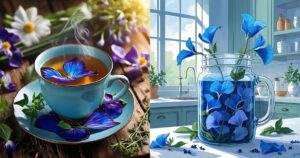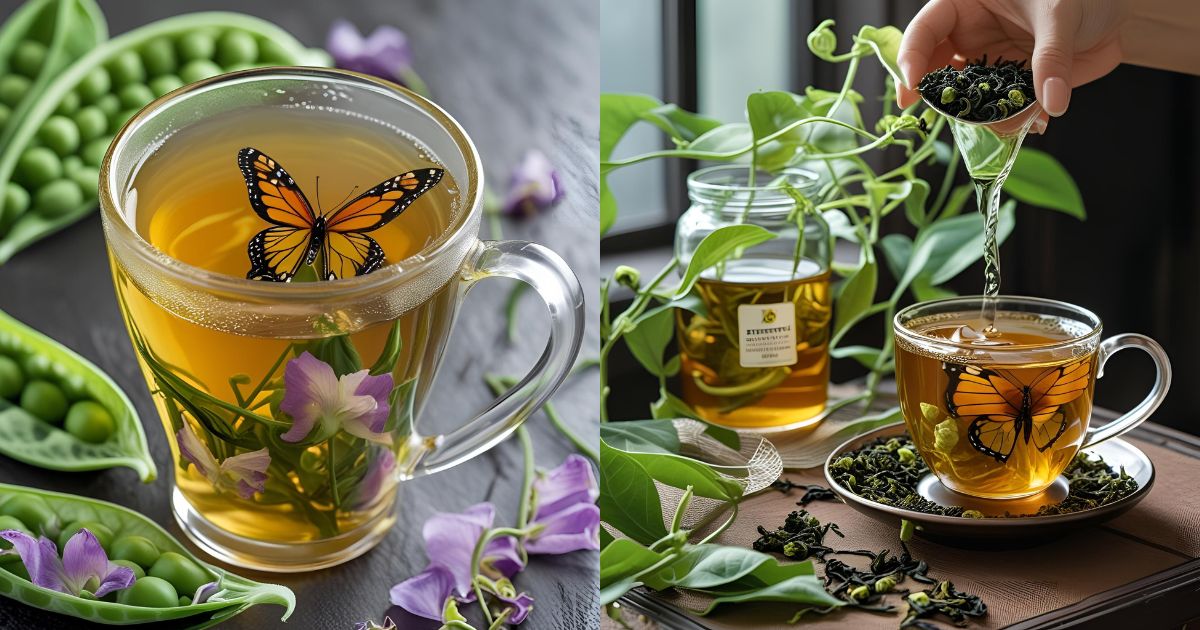Last updated on July 29th, 2025 at 12:31 am
Ever wondered why a tea turns from deep blue to vibrant purple — almost like magic?
That’s the visual allure of butterfly pea flower tea, a striking herbal drink made from the petals of Clitoria ternatea.
But this tea isn’t just for show. It’s packed with antioxidants, supports skin and hair health, and offers a calming, caffeine-free alternative to your usual brew.
From stress relief to blood sugar balance, butterfly pea flower tea benefits go far beyond aesthetics — and science is finally catching up to what ancient traditions have known for centuries.
Whether you’re into wellness, color-changing drinks, or natural nootropics, this tea belongs on your radar.
Let’s break down what makes this vibrant blue tea one of the most powerful plant-based remedies in your kitchen.
What Is Butterfly Pea Flower Tea? (Blue Tea / Blue Matcha)
Butterfly pea flower tea comes from the vibrant petals of the Clitoria ternatea plant — a striking blue bloom native to Southeast Asia.
For centuries, it’s been used in Ayurveda and traditional Thai and Indonesian medicine under names like Aprajita or blue tea.
Why? Because it was believed to:
Support memory and brain health
Promote skin clarity and healthy hair
Balance the body’s internal heat and calm the nervous system
In Thailand, it’s often served cold with lime — not just for taste, but to create that famous blue-to-purple transformation.
Today, this traditional tonic is gaining modern popularity for its wellness properties and visual magic.
Key Nutrients & Bioactive Compounds
This tea isn’t just pretty — it’s backed by powerful plant science.
Here’s what’s inside each cup:
Anthocyanins: These are the pigments responsible for its deep blue color. The dominant compound, ternatins, helps reduce oxidative stress and inflammation.
Kaempferol: A potent antioxidant linked to lower cancer risk and cellular protection.
Delphinidin-3,5-glucoside: Supports vascular and heart health.
Polyphenols & flavonoids: Natural compounds that combat free radicals and support immune function.
The combination of these bioactives makes butterfly pea flower tea a functional drink — with visible and internal benefits.
Top Health Benefits of Butterfly Pea Flower Tea

Want to know what makes this blue tea more than just a visual trend? Let’s break down the top scientifically supported and traditionally recognized benefits — with a focus on what matters most to your health and wellness.
Rich in Antioxidants & Anti‑Inflammatory Properties
This tea is loaded with antioxidants. These help your body fight oxidative stress — the same stress linked to aging, disease, and cell damage.
Why it matters:
Reduces inflammation in the body
Protects your cells from damage
Supports immunity and longevity
Blue tea antioxidant power = natural defense booster.
Cognitive & Mood Support (Brain Boost & Nootropic Effects)
Feeling foggy, anxious, or overworked? Butterfly pea tea may help.
Studies and traditional use suggest it may:
Enhance memory and brain function
Reduce anxiety and stress
Support calm focus — without caffeine
Blue pea tea benefits include functioning as a gentle nootropic — a natural brain booster.
Skin & Anti‑Aging Benefits
You can sip your way to better skin.
Thanks to its anti-glycation effects and hydrating antioxidants, this tea helps:
Prevent premature aging
Boost skin elasticity
Support collagen production
Drink it regularly and watch your skin glow — from the inside out.
Hair Growth & Scalp Health
Struggling with hair thinning or dullness?
Butterfly pea flower tea may help by:
Improving blood circulation to the scalp
Strengthening hair follicles
Slowing down greying with its rich flavonoid content
It’s like a botanical hair tonic — no chemicals required.
Blood Sugar Regulation & Metabolic Support
Early studies suggest that Clitoria ternatea benefits may extend to your metabolism.
Butterfly pea tea can:
Support insulin sensitivity
Reduce post-meal blood glucose spikes
Assist in weight management
Perfect for those looking to support blood sugar naturally — without pills.
Eye Health & Vision Support
Blue tea isn’t just good for the body — it supports your eyes, too.
Key benefits include:
Enhancing circulation to the eyes
Reducing eye fatigue from screens
Supporting night vision
Ideal for anyone staring at monitors all day (read: everyone).
Detoxification & Gentle Diuretic Effects
Need a natural cleanse?
Butterfly pea tea works as a mild diuretic, helping your body:
Flush out excess fluids
Support liver and kidney function
Eliminate toxins gently
Unlike harsh detox teas, this one cleanses without cramps.
Recap: Why People Are Drinking This Tea Daily
Beautiful color.
Science-backed benefits.
Ancient roots, modern impact.
Caffeine-free, sugar-free, side-effect free (for most).
Whether you call it blue tea, blue matcha, or Clitoria ternatea tea, this vibrant brew checks every box — beauty, brain, body, and beyond.
How to Brew & Serve Butterfly Pea Flower Tea
Want to unlock the full butterfly pea flower tea benefits? It all starts with how you brew and serve it.
Let’s break it down step by step.
Brewing Basics
Making the perfect cup is easy — no fancy tools required.
Here’s how to do it:
Dosage: Use 5–8 dried flowers per cup of water (roughly 1 teaspoon).
Water temperature: Bring fresh water to a boil, then let it cool slightly before steeping.
Steeping time: 5 to 10 minutes. The longer it steeps, the deeper the color and stronger the flavor.
Pro tip: Cover the cup while steeping to trap nutrients and aroma.
You can drink it hot or cold — both options deliver those vibrant blue tea antioxidants.
Color‑Changing Magic
Here’s what makes butterfly pea flower tea Instagram-famous: it changes color.
Add an acid like lemon or lime juice, and the deep blue hue turns into a bright purple.
Want even more color? Try:
Hibiscus for a reddish-pink blend
Sparkling water or tonics for an effervescent twist
Coconut milk or almond milk to create a calming blue latte
It’s more than a drink — it’s a sensory experience.
Serving Ideas & Creative Uses
Think beyond the teacup.
This flower is incredibly versatile in the kitchen. Use it to create:
Iced butterfly pea tea — chill and serve over ice for a refreshing summer drink
Color-changing mocktails — great for parties or kids
Butterfly pea lattes — add steamed milk, vanilla, or a hint of honey
Smoothies — blend with mango or pineapple for an antioxidant-rich boost
Baked goods — infuse into frosting, cake batter, or rice for a natural, vibrant color
Looking to impress guests or boost your own wellness routine? This is the tea that does both.
Side Effects, Safety & Who Should Be Cautious
Butterfly pea flower tea is generally safe for most people, but here’s what you need to know before making it a daily habit.
Reported Side Effects
Most people experience no issues, but some may notice:
Mild nausea
Stomach upset
Slight dizziness or low blood pressure (especially in large amounts)
If you’re new to herbal teas, start with a small serving and monitor how you feel.
Who Should Be Cautious
Some groups should speak with a healthcare provider before drinking blue pea tea regularly:
Pregnant or breastfeeding women — not enough research to confirm safety
People with diabetes — it may affect blood sugar, so monitor levels closely
Those on medications for blood pressure or clotting — potential herb-drug interactions
Best Practices for Safe Enjoyment
To get the most from butterfly pea flower tea — safely:
Stick to 1–2 cups per day
Avoid sweetening it with refined sugar (use honey or drink it plain)
If you’re on medication, consult your doctor first
Store dried flowers in a cool, dry place to preserve their potency
Enjoy the benefits, but respect the brew.
Scientific Evidence & Research Overview
Butterfly pea flower tea boasts centuries of traditional use — but what does the science say?
Here’s a quick comparison:
| Claim | Traditional Use | Scientific Backing |
|---|---|---|
| Antioxidant & anti-inflammatory | Ayurvedic tonic, longevity herb | ✅ In vitro & animal studies confirm presence of polyphenols & flavonoids |
| Memory & cognitive support | Brain clarity, stress relief | ✅ Small animal studies show potential nootropic effects |
| Blood sugar regulation | Balanced energy | ⚠️ Small human trials suggest improved insulin response; more research needed |
| Skin & hair benefits | Radiant skin, thick hair | ⚠️ Limited evidence; mostly anecdotal or based on antioxidant effects |
| Weight management | Light detox, fat-burning tea | ❌ No strong direct clinical data yet |
| Vision support | Eye clarity, night vision boost | ⚠️ Minimal data; more anecdotal/traditional claims |
Bottom line: Many benefits are biologically plausible, but human studies are limited. Still, early findings and traditional use suggest this tea is worth exploring.
Testimonials & Community Insights
Want to know what real users say? Here’s what the butterfly pea tea community shares on Reddit and wellness sites:
“It acts as a nootropic… antioxidant, anti-inflammatory… helps with cognition… alternative to caffeine.” — Reddit
“Yes, butterfly pea flower tea is good for you… rich in antioxidants… supports heart, brain, skin, hair…” — The Qi
Other users highlight benefits like:
Calm focus without a crash
Better digestion
Improved skin glow over time
Eye-catching color that makes hydration fun
It’s not just trendy — people are genuinely integrating it into their wellness routines.
Conclusion
Butterfly pea flower tea offers a powerful combo: eye-catching beauty, ancient wellness roots, and emerging scientific support.
From antioxidants and brain-boosting effects to skin and hair support — it’s a caffeine-free herbal drink that fits perfectly into a mindful, modern lifestyle.
Frequently Asked Questions
Does butterfly pea tea help with weight loss?
It may help indirectly. The tea is low-calorie, caffeine-free, and mildly diuretic — all of which support hydration and digestion. But no studies confirm direct fat-burning effects.
Can I drink it daily?
Yes — 1 to 2 cups daily is generally safe for most people. It’s caffeine-free and rich in antioxidants.
Will it affect pregnancy or breastfeeding?
There’s not enough research. Avoid regular use during pregnancy or lactation unless advised by a doctor.
Why did my urine or stool change color?
The natural pigments (anthocyanins) can sometimes tint urine or stool. It’s harmless — and temporary.
Is it caffeine-free?
Yes. Butterfly pea flower tea is naturally caffeine-free, making it perfect for evening use or caffeine-sensitive individuals.
How much should I drink?
1–2 cups per day is ideal. Always start small and observe how your body reacts.

Md Emon is our dedicated tea specialist, passionately unraveling the world of tea—from delicate white teas and robust pu-erhs to aromatic chai blends and matcha rituals. With years of hands-on experience in sourcing leaves, studying brewing techniques, and analyzing tea traditions across cultures, he combines deep subject knowledge with practical insights. Whether you’re exploring caffeine levels, health benefits, or the art of perfect steeping, Md Emon delivers precise, research-backed guidance to steep your tea journey in confidence.

